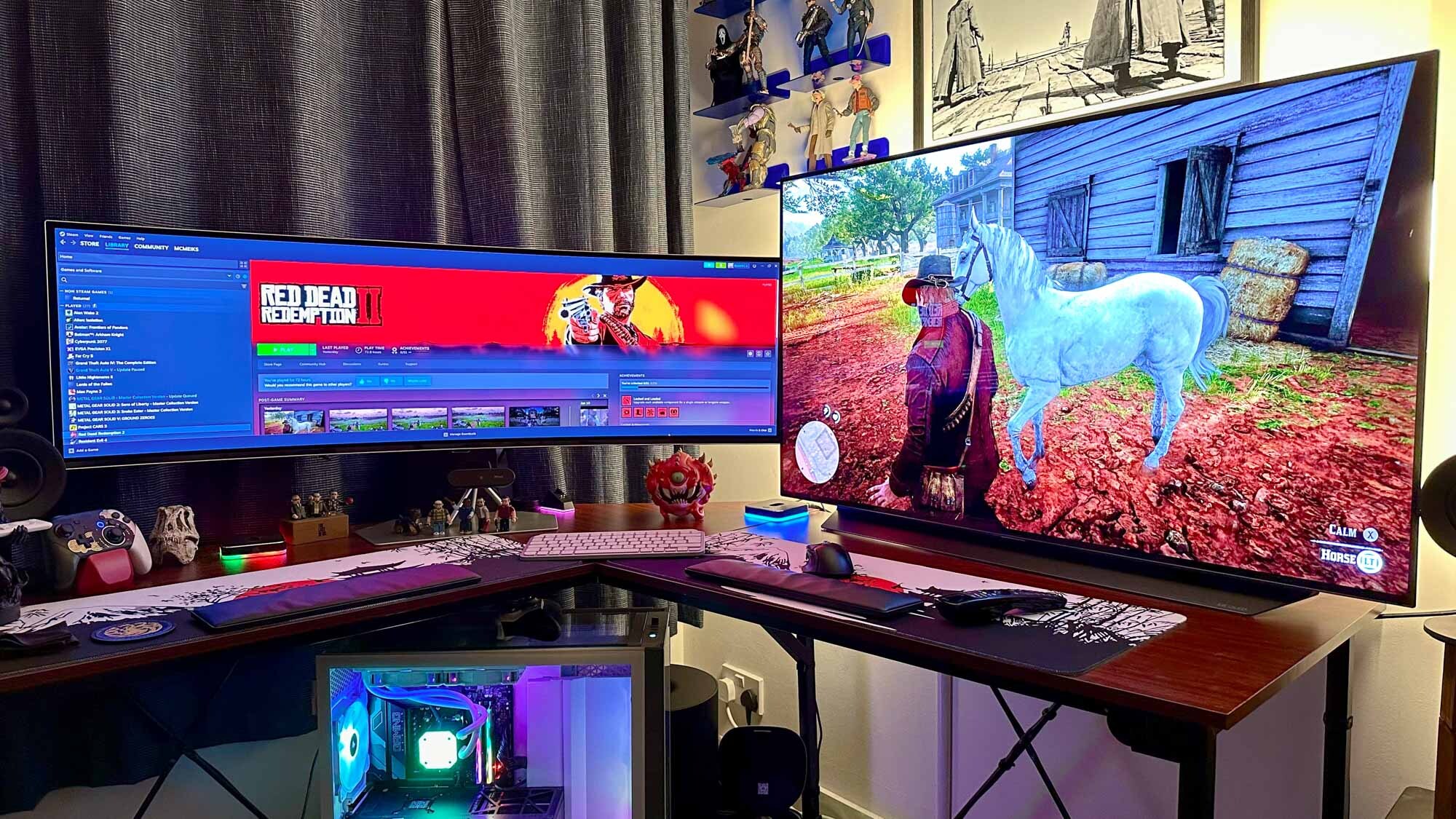I switched to this ultrawide monitor — and it's a huge boost for my productivity
32:9 aspect ratio displays are amazing for both work and play

After buying a 49-inch super ultrawide monitor on Black Friday late last year, I can legitimately say it’s made doing my job easier.
It’s hardly like I was slumming it with my previous home office kit, though. I still own and use the 48-inch LG C2 OLED TV that acted as half of my dual-screen setup, and it’s a great (slightly left field) alternative to one of the best gaming monitors.
Ironically, that’s exactly what I just upgraded to.
Right now, the Samsung Odyssey OLED G9 49" Curved Gaming Monitor is on sale for $1,299 at Best Buy. That's a juicy saving of $500 from its normal retail price of $1,799.
Samsung Odyssey OLED G9 49" Curved Gaming Monitor: was $1,799 now $1,299 @ Best Buy
The king of gaming super ultrawide gaming monitors. Yes, you'll need a desk the size of a soccer field to house this monster, but it's asbolutely worth it. Its 240Hz refresh rate means you can absolutely obliterate games if your PC has a beefy GPU, while the sheer size of its 32:9, 49-inch screen makes it ideal for jumping between work-based tasks.
‘Round these parts, we generally consider the excellent Alienware AW3423DWF to be the best ultrawide gaming monitor you can currently buy. So why on Earth would I “upgrade” what’s arguably the best display I’ve ever had hooked up to my PC?
To be clear, there’s precisely nothing wrong with the AW3423DWF. It’s an utterly terrific QD-OLED gaming panel that boasts an HDMI 2.1 port — making it one of the best PS5 monitors. At 34 inches with a native screen resolution of 3440 x 1400 and support for AMD FreeSync, perfect black levels and impeccable screen uniformity, it’s the ultrawide to beat in my book.
When you’re dealing with such a uniquely large and in charge aspect ratio, multitasking becomes so much simpler than on a vanilla 16:9 display.
Of course, it ain’t super ultrawide. Let’s do a quick lesson on the two formats, shall we?
Get instant access to breaking news, the hottest reviews, great deals and helpful tips.
An ultrawide display rocks a 21:9 aspect ratio, which gives you considerably more horizontal screen real estate than regular 16:9 monitors. Using an ultrawide makes having multiple browser windows open far more convenient, while also letting you really take advantage of cranking up FOV (Field of View) settings in the best PC games.
There's no doubt about it — I love gaming/working on a 21:9 screen.
So it’s somewhat awkward that I dig 32:9 aspect ratio, super ultrawide monitors just that little bit more. I nabbed a truly stellar deal on the Samsung Odyssey OLED G9 during a little known sales event last year, and what a purchase it’s been.
While it’s primarily promoted as a gaming monitor — and with good reason, which I’ll get onto in a second — it’s an absolute joy to work on. When you’re dealing with such a uniquely large and in charge aspect ratio, multitasking becomes so much simpler than on a vanilla 16:9 display.
Size matters

With 49-inches spread over a 32-inch aspect ratio, it’s essentially like having two widescreen monitors joined together. The Odyssey OLED G9 is a fantastic alternative to a dual-monitor setup. Of course, my rig is still hooked up to two screens, so you can imagine the size of the L-shaped desk that has to accommodate both a super ultrawide monitor and a 48-inch TV. Spoiler: it’s big.
The Odyssey OLED G9’s screen makes it one of the best PC monitors. This thing is a titan. With a native resolution of 5,120 x 1,400 and screen curvature of 1,800R, the experience of viewing or interacting with any sort of content on the G9 can’t be described as anything less than “cinematic”.
I don’t care if you’re bashing beasties in Doom Eternal on a screen that rocks an absurd 240Hz refresh rate or are going over your taxes on a spreadsheet so boring, you want to carve your eyeballs out with a spoon. When you view anything on the Odyssey OLED G9, you can’t fail to be impressed by its astonishing form factor.
I’ve been working in some form of journalism since 2006, and I can tell you right now the upcoming sentence is the most pathetic-sounding collection of words I’ve ever put together. Last night, I had three Google Chrome windows, with each one occupying precisely a third of the G9’s screen and out of sheer curiosity, I broke out a little measuring tape and took note of exactly how wide each one was. The answer was precisely 15.3-inches, which is a whole lot of screen space when you’re talking about having three equally sized tabs open at any given time.
And as someone who regularly uses Adobe Photoshop for their job, it’s a godsend being able to snap between two windows that measure 22.8 inches — I'm being ultra geeky here and not factoring in the width of the (reasonably) slim bezels of this Samsung.
32:9 is a dream aspect ratio for multitasking when swapping between work projects
Though it supports Nvidia G-Sync, boasts a response time of just 0.03ms seconds, and is absolutely mesmerizing when playing racing games like Forza Horizon 5, I’ve found myself using what is a phenomenal gaming monitor primarily as a display to do my job on.
That’s partially because 32:9 is a dream aspect for multitasking when swapping between work projects (and on a slightly sour note), that support for the format in most of the best Steam games doesn’t cut the mustard. If you’re into story-driven games like Alan Wake 2, prepare for colossal black vertical borders during cutscenes.
That’s the only shade I’m going to throw at the Samsung Odyssey OLED G9, as this is a monitor that completely deserves the Editor’s Choice award my computing colleague Tony Polanco awarded it last summer. Whether you’re chasing ultra immersive game experiences or want to be able to switch between 15 different on-screen browser tabs with ease, the G9 is one hell of a screen for both work and play.
More from Tom's Guide
- I’ve been using my OLED TV as a PC monitor for six months — here’s what happened
- I've started playing my PC on my living room OLED — it's been a revelation
- The best monitors: Tried and tested

Dave is a computing editor at Tom’s Guide and covers everything from cutting edge laptops to ultrawide monitors. When he’s not worrying about dead pixels, Dave enjoys regularly rebuilding his PC for absolutely no reason at all. In a previous life, he worked as a video game journalist for 15 years, with bylines across GamesRadar+, PC Gamer and TechRadar. Despite owning a graphics card that costs roughly the same as your average used car, he still enjoys gaming on the go and is regularly glued to his Switch. Away from tech, most of Dave’s time is taken up by walking his husky, buying new TVs at an embarrassing rate and obsessing over his beloved Arsenal.

